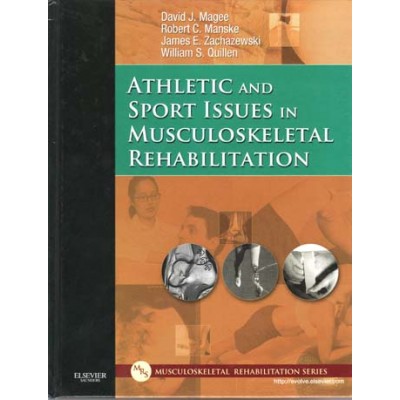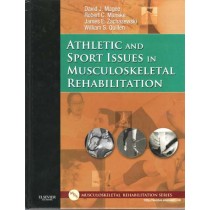
Athletic and Sport Issues in Musculoskeletal Rehabilitation: Module 5
SKU: 755
by David J. Magee, PT, PhD, Robert C. Manske, PT, DPT, SCS, Med, ATC, CSCS, James E. Zachazewski, PT, DPT, SCS, ATC, and William S. Quillen, PT, PhD, SCS, FACSM
These courses are offered in cooperation with Elsevier Health and utilize the hardback textbook, “Athletic and Sport Issues in Musculoskeletal Rehabilitation” by David J. Magee, PT, PhD, Robert C. Manske, PT, DPT, SCS, Med, ATC, CSCS, James E. Zachazewski, PT, DPT, SCS, ATC, and William S. Quillen, PT, PhD, SCS, FACSM.
These courses provide expert insight and clear rehabilitation guidelines to help you manage injuries and special medical needs unique to your athletic clients. Contributions from leading physical therapists, athletic trainers, physicians and orthopedic surgeons give you a comprehensive, clinically relevant understanding of common sports-related injuries and help you ensure the most effective therapeutic outcomes. These courses are essential to everyone on the sports medicine team!
Module 1: covers preparation and prevention in sports medicine including the role of the sports medicine team, pre-participation physical fitness profiling, psychosocial aspects of youth sports and nutrition counseling and athletes.
Module 2: covers preparation and prevention in sports medicine including environmental considerations for sports, use of ergogenic aids in sports and sports drug testing issues
Module 3: covers applied biomechanics of cycling, golf, jumping and tennis
Module 4: covers applied biomechanics of soccer, running, swimming and baseball pitching
Module 5: covers management of sports injury and illness including delayed-onset muscle soreness, medical conditions in sport, dermatologic considerations in athletics and protective equipment in sports
Module 6: covers management of sports injury and illness including sports related concussions, traumatic injuries to the cervical spine, maxillofacial injuries and abdominal and thoracic injuries.
Module 7: covers special populations and epidemiology including the female athlete, musculoskeletal dance medicine and science, the athlete with disabilities, and selected rehabilitation needs of the masters athlete.
Module 8: covers applied biomechanics of common weight training exercises, taping for athletics and rehabilitation and applied sports injury epidemiology
Course Length: 8.0 contact hours
Instructional level: Intermediate
This package contains the reading and testing materials for Module 5 only.
Athletic and Sport Issues in Musculoskeletal Rehabilitation: Module 5
Course Goals and Objectives:
Course Goals: This course is intended to instruct the student through self paced study on the foundations of providing intervention for athletes as it relates to delayed onset muscle soreness, medical conditions and dermatologic considerations in athletics, and protective equipment in several types of sports
Student Objectives:
At the end of this course, the student will be able to:
1. Evaluate muscle receptors and pressure-mediated pain.
2. Evaluate the recovery time for DOMS.
3. Understand the relationship of maximal lengthening contractions in DOMS.
4. Analyze the relationship of calcium and skeletal muscle injury.
5. Identify four proteins and their relationship to lengthening skeletal muscle contractions.
6. Evaluate the effect of ibuprofen on DOMS.
7. Evaluate the effect of ice massage and constant compression on DOMS.
8. Evaluate the types of massage associated with DOMS.
9. Understand the difference between static/ballistic stretching as it relates to muscle soreness.
10. Evaluate four types of cardiovascular abnormalities and sudden death in athletes.
11. Understand medications used to control hypertension in athletes.
12. Evaluate four properties of Marfan syndrome.
13. Understand four common infections in athletes.
14. Understand four medications and their effect on high altitude sickness.
15. Evaluate the normal recovery time from acute gastroenteritis.
16. Identify the cause of infectious mononucleosis.
17. Evaluate the effect of mononucleosis on four organs in the body.
18. Understand the emergency treatment for hypoglycemia.
19. Evaluate the timeline of the body’s response to proteinuria.
20. Understand the effects of overtraining in athletes.
21. Evaluate the need for passive stretching when providing intervention for myositis ossificans.
22. Understand the cellular structure of the epidermis.
23. Evaluate the location of eccrine glands.
24. Evaluate petechiae bruises.
25. Understand the appropriate pharmacological considerations for pustulocystic acne.
26. Understand the correct treatment for subungual hemorrhages.
27. Understand the pharmacological treatment for psuedobursitis.
28. Evaluate the location for tinea manuum.
29. Understand pharmacologic treatment for herpes simplex.
30. Understand four different vitamins and sun exposure.
31. Evaluate the difference between closed and open cell foam.
32. Evaluate four casting materials.
33. Understand the proper fit of a football helmet.
34. Understand the attachment points of a chinstrap to football and lacrosse helmets.
35. Understand four classes of eye protection as it relates to sports.
36. Understand four football positions as they relate to types of shoulder pads required.
SKU: 755
by David J. Magee, PT, PhD, Robert C. Manske, PT, DPT, SCS, Med, ATC, CSCS, James E. Zachazewski, PT, DPT, SCS, ATC, and William S. Quillen, PT, PhD, SCS, FACSM
These courses are offered in cooperation with Elsevier Health and utilize the hardback textbook, “Athletic and Sport Issues in Musculoskeletal Rehabilitation” by David J. Magee, PT, PhD, Robert C. Manske, PT, DPT, SCS, Med, ATC, CSCS, James E. Zachazewski, PT, DPT, SCS, ATC, and William S. Quillen, PT, PhD, SCS, FACSM.
These courses provide expert insight and clear rehabilitation guidelines to help you manage injuries and special medical needs unique to your athletic clients. Contributions from leading physical therapists, athletic trainers, physicians and orthopedic surgeons give you a comprehensive, clinically relevant understanding of common sports-related injuries and help you ensure the most effective therapeutic outcomes. These courses are essential to everyone on the sports medicine team!
Module 1: covers preparation and prevention in sports medicine including the role of the sports medicine team, pre-participation physical fitness profiling, psychosocial aspects of youth sports and nutrition counseling and athletes.
Module 2: covers preparation and prevention in sports medicine including environmental considerations for sports, use of ergogenic aids in sports and sports drug testing issues
Module 3: covers applied biomechanics of cycling, golf, jumping and tennis
Module 4: covers applied biomechanics of soccer, running, swimming and baseball pitching
Module 5: covers management of sports injury and illness including delayed-onset muscle soreness, medical conditions in sport, dermatologic considerations in athletics and protective equipment in sports
Module 6: covers management of sports injury and illness including sports related concussions, traumatic injuries to the cervical spine, maxillofacial injuries and abdominal and thoracic injuries.
Module 7: covers special populations and epidemiology including the female athlete, musculoskeletal dance medicine and science, the athlete with disabilities, and selected rehabilitation needs of the masters athlete.
Module 8: covers applied biomechanics of common weight training exercises, taping for athletics and rehabilitation and applied sports injury epidemiology
Course Length: 8.0 contact hours
Instructional level: Intermediate
This package contains the reading and testing materials for Module 5 only.
Athletic and Sport Issues in Musculoskeletal Rehabilitation: Module 5
Course Goals and Objectives:
Course Goals: This course is intended to instruct the student through self paced study on the foundations of providing intervention for athletes as it relates to delayed onset muscle soreness, medical conditions and dermatologic considerations in athletics, and protective equipment in several types of sports
Student Objectives:
At the end of this course, the student will be able to:
1. Evaluate muscle receptors and pressure-mediated pain.
2. Evaluate the recovery time for DOMS.
3. Understand the relationship of maximal lengthening contractions in DOMS.
4. Analyze the relationship of calcium and skeletal muscle injury.
5. Identify four proteins and their relationship to lengthening skeletal muscle contractions.
6. Evaluate the effect of ibuprofen on DOMS.
7. Evaluate the effect of ice massage and constant compression on DOMS.
8. Evaluate the types of massage associated with DOMS.
9. Understand the difference between static/ballistic stretching as it relates to muscle soreness.
10. Evaluate four types of cardiovascular abnormalities and sudden death in athletes.
11. Understand medications used to control hypertension in athletes.
12. Evaluate four properties of Marfan syndrome.
13. Understand four common infections in athletes.
14. Understand four medications and their effect on high altitude sickness.
15. Evaluate the normal recovery time from acute gastroenteritis.
16. Identify the cause of infectious mononucleosis.
17. Evaluate the effect of mononucleosis on four organs in the body.
18. Understand the emergency treatment for hypoglycemia.
19. Evaluate the timeline of the body’s response to proteinuria.
20. Understand the effects of overtraining in athletes.
21. Evaluate the need for passive stretching when providing intervention for myositis ossificans.
22. Understand the cellular structure of the epidermis.
23. Evaluate the location of eccrine glands.
24. Evaluate petechiae bruises.
25. Understand the appropriate pharmacological considerations for pustulocystic acne.
26. Understand the correct treatment for subungual hemorrhages.
27. Understand the pharmacological treatment for psuedobursitis.
28. Evaluate the location for tinea manuum.
29. Understand pharmacologic treatment for herpes simplex.
30. Understand four different vitamins and sun exposure.
31. Evaluate the difference between closed and open cell foam.
32. Evaluate four casting materials.
33. Understand the proper fit of a football helmet.
34. Understand the attachment points of a chinstrap to football and lacrosse helmets.
35. Understand four classes of eye protection as it relates to sports.
36. Understand four football positions as they relate to types of shoulder pads required.





